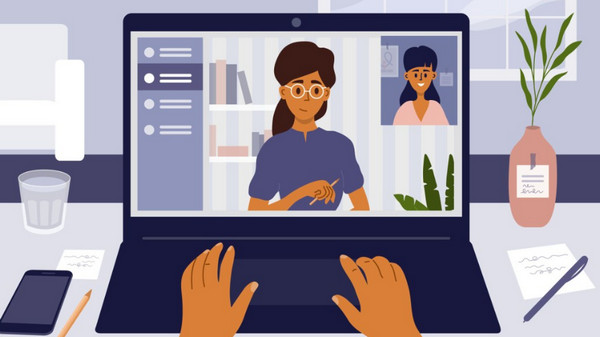[Tutorial] The Best Tips to Record Interview in 2025
When conducting or attending an interview, capturing accurate information is crucial for your review later. While note-taking is a go-to method, recording a video interview now ensures you won’t miss any details. How? This guide will explore the four common interview recording types, from in-person to hybrid types of interviews. At the end of this article, you can choose the best method to record interview, depending on your needs.
4 Common Interview Recording Types
Recording an interview is necessary whether you’re doing it for research, hiring, podcasting, journalism, or other purposes. Your setup will vary depending on the format, whether in-person, remote, over the phone, or hybrid. You must have the right tools to not only record the interview but also have high-quality video and audio, minimizing technical issues. As you learn about the four common types of interviews below, you’ll see the best recording methods, tools, and devices for each.
1. In-Person Interviews

In-person interviews offer the most natural interaction, where body language and expressions are observed, such as a job interview or research interview. These interviews can be recorded with various apps, especially if you’re using a laptop or computer.
Recommended Tools:
- Interview recorder. You will have a recording tool for in-person interviews that captures high-quality video and audio with minimal setup.
AnyRec Screen Recorder for PC captures excellent video and audio directly from your PC. One of its strengths is its ability to record an external mic and a webcam, which is great for recording an interview. It also includes real-time audio monitoring and basic editing tools. Whether you’re recording a formal interview in an office or just a casual conversation, AnyRec Screen Recorder provides flexible options. On the other hand, for mobile recording apps, you can get the AZ Screen Recorder, Record It!, etc.
Secure Download
Secure Download
- Platform. Since this type of interview doesn't need an internet-based platform, your main platform will be your recording software.
- Device. As for the device, a laptop or computer is suggested if you’re using AnyRec Screen Recorder. For mobile setups, a smartphone and a tablet are good.
- Microphone/Camera. To get a professional sound quality, you can use a lavalier mic on the interviewee. If you’re recording a video, a DSLR camera or smartphone with a high-quality lens can provide excellent visuals.
2. Remote Interviews

Meanwhile, remote interviews have become increasingly popular nowadays due to their convenience. This type is usually done via video conferencing tools like Zoom, Skype, Google Meets, Microsoft Teams, and more, all of which have a built-in recording feature to record video and audio interview.
Recommended Tools:
- Recorder. Since most video conferencing platforms already have a built-in recording feature, you can directly record interviews here.
- Platform. Popular choices include Zoom, Skype, Google Meet, and MS Teams. All these offer features like Zoom recorder, screen sharing, virtual backgrounds, and chat.
- Device. Use a desktop or laptop with a strong internet connection for the best experience.
- Microphone/Camera. To achieve professional sound quality, use a USB condenser mic like Rode NT-USB Mini. You can also have a webcam like the Logitech C920.
3. Phone Call Interviews

Phone call interviews are especially utilized in journalism or the initial hiring stages, where a convenient conversation is needed. Thankfully, you can use several recording apps here that capture both ends of the call with clear audio.
Recommended Tools:
- Recorder. For phone interviews, iPhone users can rely on Rev Cal Recorder, which records in-person interviews on both ends of the conversation. Android users can use Cube ACR, which offers automatic and manual recording.
- Platform. There is no video platform needed here; it is just the native phone application.
- Device. A smartphone is the main device used in this type of interview.
- Microphone/Camera. If you’re recording interviews via speakerphone, you can have a portable recorder or an external mic for clearer sound.
4. Hybrid Interviews

Finally, the hybrid interviews combine both in-person and remote formats, where one participant is physically present while the other one joins remotely. These setups need thoughtful coordination to ensure both ends are clearly captured.
Recommended Tools:
- Recorder. AnyRec Screen Recorder also works well to record interview in a hybrid setup, as one participant is in-person and the other is remote. The recorder lets you record your mic and the audio/video from the conferencing platform, while ensuring both sides are captured clearly and of high quality.
- Platform. As for the platform, you can use a remote meeting like Zoom on a laptop or tablet to connect with the remote participant.
- Device. You will need two devices here: a laptop to connect to the guest via a video platform, and another device, like a smartphone or recorder, to capture in-person audio/video if your main device’s mic is not ideal.
- Microphone/Camera. For best results, use a lavalier microphone for the participants and ensure they use a headset mic. An HD webcam is also suggested to capture visuals.
Tips for Better Interview Recording
That ends the discussion about the interview types, featuring the recorder, platforms, device, and more that you should use to record the interview. But before concluding this post, a few steps must be taken to have a better interview recording. See below the tips to help you plan, execute, and polish your interview recordings.
- 1. Do Your Research. You must learn about your guest and the topic you would talk about, helping you ask insightful questions and execute the conversation smoothly.
- 2. Have Proper Equipment. Use reliable tools such as a good-quality mic, headphones, webcam, and recording software.
- 3. Ready Your Backup Device. Always keep a secondary one running, such as a smartphone, in case your main setup fails.
- 4. Ensure a Strong Internet Connection. Primarily for remote interviews, check your internet connection first to prevent lag and dropouts.
- 5. Send Your Guest Equipment. If possible, consider mailing a mic or headset to your guest. Doing so will help the interview flow smoothly, especially if it is part of a show.
- 6. Avoid Noisy Environments. Choose a quiet location in your home. Turn off anything that can add distractions and background noises.
- 7. Make a Test Recording. Before getting started to record interview, do a short test to ensure audio levels, quality, and background are all good.
- 8. Always Ask Permission Before Recording. Whether it is in-person, phone, or remote, always get consent before you hit the record button.
- 9. Ask the Right Questions. Since you’ve researched, prepare thoughtful questions that will allow your guest to expand on ideas and share their insights.
- 10. Polish Your Interview Recording. After everything, you can edit out background noise or any pauses that will make your interview recording more professional.
Conclusion
By understanding the types of interviews, in-person, remote, phone call, and hybrid, you can have the right tools and setup to record interview. Plus, by following the best tips like using quality equipment, minimizing background noise, testing your setup, etc., you can make a huge difference in your final interview recording output. Speaking of equipment, AnyRec Screen Recorder is an excellent choice for a reliable recording solution across all interview formats. It offers high-quality audio and video, built-in editing, customizable settings, and a lot more—perfect for interviewers who wish for nothing but stress-free recording.
Secure Download
Secure Download
